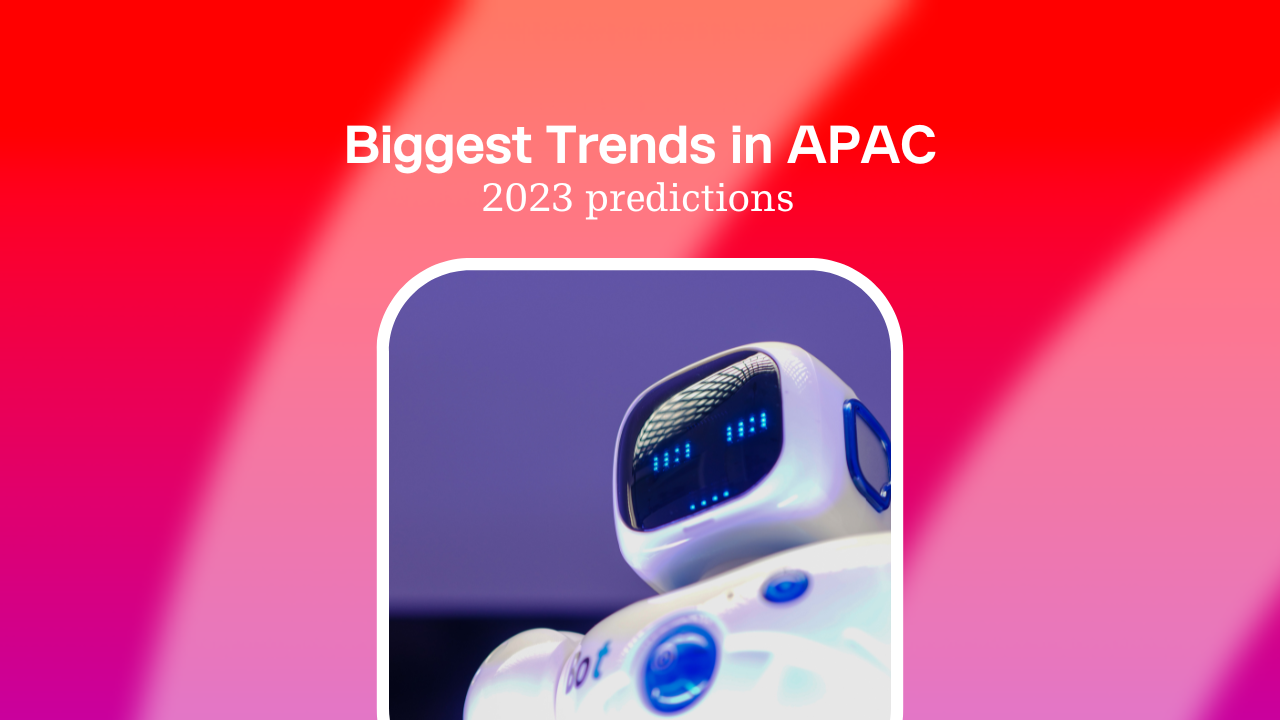Insights >
2023 Biggest APAC Trends


New: Japanese Consumer Behaviour – 2025 report | download for FREE >>


With over 2.5 billion internet users, which amounts to about 55% of all internet users, the Asia Pacific region boasts the highest number of internet users in the world. The region has also gone through vast and rapid digital transformation over the past few years, a result of the global pandemic.
This widespread internet adoption and changes brought on by digital transformation have resulted in great development within the digital marketing sector. In today’s video we discuss five digital marketing trends we expect to see in 2023 across the APAC region.
More companies have been using and will continue to use artificial intelligence to improve customer experience, personalisation, and creative testing. Data from AI-based applications can help marketers tremendously to extract customer insights. This can help align marketing, sales, and customer service goals.
Table of Contents
Using AI to do things like improve user segmentation, ad optimisation, budget allocation, sales forecasting and more can be especially useful in APAC, where there is a wide range of languages, cultures, and markets.
There were first instances of AI influencers, who are signing brand deals and have a massive social following. Examples includee South Korean influencer Rozy, or Chinese Ayayi.
Although the elimination of cookies has been pushed back by Google, yet again, this time to the end of 2024, the phasing out of third-party data will no doubt be heavy on the minds of marketers in 2023. This will certainly be a huge blow to many, as one study found that 80% of advertisers rely on cookies to reach their customers and personalise ads. However, a study by Dentsu revealed that 60% of marketers are not familiar with tracking prevention or are unsure about the consequences of the eradication of cookies on their business. This indicates that this new policy change is not yet well understood by the majority of marketers.
To prepare for a cookie-less world, marketers should prioritise building direct relationships with their customers, invest in technology that prioritises privacy, and establish clear privacy policies to gain their customer’s trust through transparency.
This trend will also strengthen the need of implementing a multichannel strategy and diversifying ad spend across platforms, businesses can reach new audiences, grow brand recognition, and increase revenue despite stiff competition and rising digital advertising costs.
The sheer popularity of social media in Asia has given rise to influencer marketing. Even B2B brands have embraced influencer marketing, with companies like NetApp Japan and Lenovo Japan partnering up with influencers in 2021, or Samsung partnering with Chinese KOLs (Key Opinion Leaders aka influencers) in 2022.
We expect this trend to continue in 2023. Influencer marketing campaigns are particularly effective for B2B businesses hoping to increase brand awareness, reach new target customers, increase sales, or improve their brand image.
The popularity of voice search is increasing every year. Consumers are using it to shop, get directions, text friends, and get answers from search engines. It is particularly popular in the Asia Pacific region, as 49% of respondents in this study by Statista stated that they had accessed voice search recently, making this “region the clear leader in terms of voice search adoption”.
Therefore, marketers will need to also adjust their strategies to align with this new user behaviour. For example, the way people search online is different depending on if they are typing it versus saying it out loud. When searching for marketing automation tools, one might type out ‘best martech tools 2022’. But when using voice search, one might instead say, “What are the best marketing automation tools this year?”
COVID-19 has spurred even more enthusiasm for ecommerce across the region. A study by Bain & Company and Facebook found that people in Southeast Asia are buying more essential goods online, with 28% having tried a new ecommerce for the first time since the beginning of the pandemic.
The study also found that live ecommerce, in which products are sold via live stream, has also grown in popularity. 39% of all ecommerce engagements happen through live ecommerce, while the remaining 61% involve traditional ecommerce. People are also now more receptive to grocery shopping online: 43% of respondents said they shopped online for packaged groceries in 2020.
Marketing technology company Criteo also saw a huge spike in ecommerce sales across the region, particularly around Singles’ Day. Sales in Malaysia and Thailand increased by 600% and 305% respectively and Singapore’s sales grew 248%.
Japan’s ecommerce market also saw immense growth, as COVID-19 drew an unprecedented number of Japanese people to online food delivery and shopping platforms. Shopify even reported that Black Friday-Cyber Monday sales grew 350% in 2020.
Our team of bilingual Japanese experts can support you or your agency with online ads, ecommerce strategy, SEO localisation, social media marketing, and more. Get in touch to learn more about our services and how our consultants can support you.